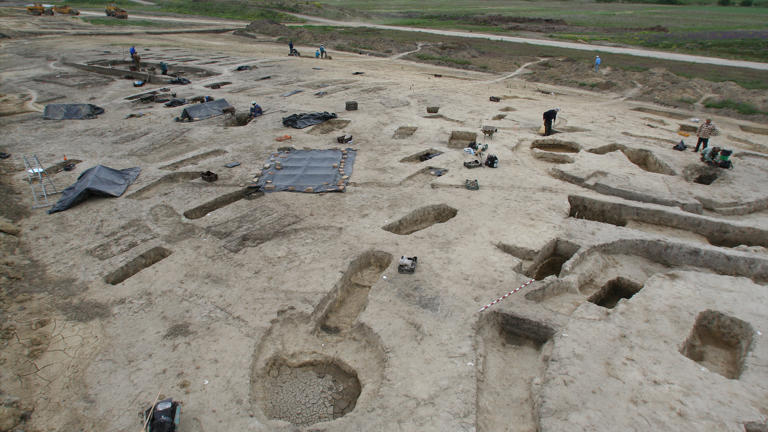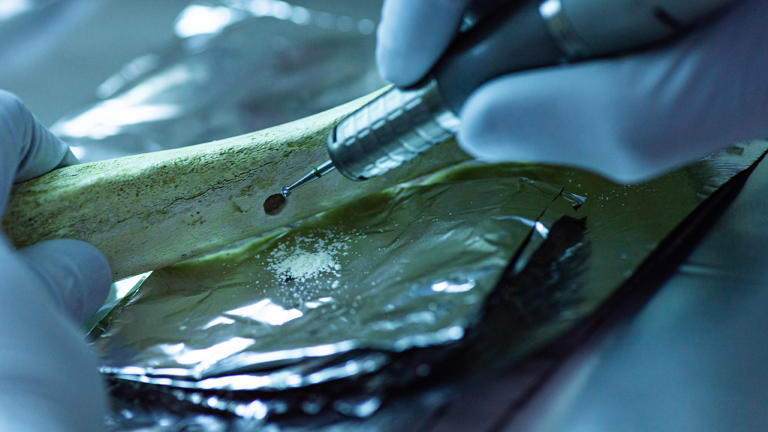DNA ANALYSIS SPANNING 9 GENERATIONS OF PEOPLE REVEALS MARRIAGE PRACTICES OF MYSTERIOUS WARRIOR CULTURE












DNA analysis spanning 9 generations of people reveals marriage practices of mysterious warrior culture
Hundreds of skeletons found in cemeteries on the Great Hungarian Plain reveal clues about nine generations of Avars, a mysterious warrior culture that dates back nearly 1,500 years. A new analysis of the remains suggests that men stayed put while women married into the culture and that it was common for people to have multiple partners.
In a study published Wednesday (April 24) in the journal Nature, an international team of researchers conducted DNA analysis on 424 skeletons located in four Avar cemeteries in present-day Hungary. Based on those results, the team identified 298 people who were closely biologically related, and they mapped out family trees across nearly three centuries.
The Avar people settled in the Carpathian Basin starting in the mid-sixth century. The political core of this group included a khagan, a political leader who was surrounded by elite horse-mounted warriors and their families. Originally nomadic, the Avars established stable settlements in the early seventh century and buried their dead in large cemeteries, sometimes in ostentatious tombs filled with weapons, jewelry and horses. Although the Avars controlled a large realm from approximately contemporary Hungary to Bulgaria, their rule ended around A.D. 800 after they were invaded by Charlemagne and his army.
The Avars left no written history, and their language is preserved only as occasional words in contemporaneous Latin and Greek texts. But half a dozen previous research studies in the past decade have attempted to determine the origins of the Avar people through their DNA, ultimately finding considerable genetic influences from European, Eurasian and Northeast Asian populations.
In the new study, the research team used software to calculate genetic relatedness from the DNA results. They found that most people were related to others in the same cemetery and that women's origins were more diverse than men's, suggesting that women married into the male-centered Avar culture. More specifically, women's parents were not found in the cemeteries, while men descended from the founding males of their family tree. Related individuals were almost always buried together.
"This suggests that Avar women left their homes to join their husbands' communities, which might have provided some social cohesion between distinct patrilineal clans," Lara Cassidy, a research assistant in the Department of Genetics at Trinity College Dublin who was not involved in the study, wrote in an accompanying News & Views article published in Nature.
The genetic analysis revealed that both men and women commonly had children with more than one partner. It also produced clear evidence for a practice called levirate, which is when closely related men have children with the same woman, often following the death of one of the men. The team found three pairs of fathers and sons, two pairs of brothers, and an uncle and nephew who each had shared a female partner.
"All the aforementioned phenomena lead us to assume that the segment of Avar society we investigated had a structure comparable to that of Eurasian pastoralist steppe people," particularly in terms of patrilineality or male-reckoned descent, the researchers wrote in their study.
By studying the specific lineages, or patrilines, the team also discovered that, in the large Rákóczifalva cemetery, there were shifts in genetics, food resources and grave types in the second half of the seventh century, suggesting a political transition as one patriline took power from another.
"This community replacement reflects both an archaeological and dietary shift that we discovered within the site itself, but also a large-scale archaeological transition that occurred throughout the Carpathian Basin," study co-first author Zsófia Rácz, an archaeologist at Eötvös Loránd University in Budapest, said in a statement.
Ultimately, the large-scale ancient-DNA analysis done in this study showcased the intricacies of Avar relationships, revealing that "the society maintained a detailed memory of its ancestry and knew who its biological relatives were over generations," co-first author Guido Alberto Gnecchi-Ruscone, an archaeogeneticist at the Max Planck Institute for Evolutionary Anthropology in Leipzig, Germany, said in the statement.
Articles - Latest
- Earthquakes can trigger quartz into forming giant gold nuggets, study finds
- Linda Nolan, singer and television personality, dies aged 65
- Sly Stone, pioneering funk and soul musician, dies aged 82
- Dangers of an overloaded car include:
- Natural Disaster today
- Japan earthquake: Kushiro shakes for 'too long' as 6.1 mag tremor hits
- 'Cult' members jailed over coroner kidnap plot
- Flood risk threatens Swiss valley after glacier destroys village
- Thailand Grapples with Floods and Economic Shifts: Government Response, Community Resilience, and Market Predictions
- Powerful hailstorm floods buildings and streets in Gniezno
- The Significance of the 49-Day Journey After Death
- Killing prisoners for transplants: Forced organ harvesting in China
- Southern Japan hit by 6.6-magnitude quake near Nankai Trough, tsunami warnings lifted
- Peru’s coastline battered by tsunami-like waves one day after country declares environmental emergency
- California fires live updates: ‘Dangerous’ winds return as residents are warned over threat of new wildfires
- Osibisa founding member and singer Teddy Osei dead at 88
- Oliviero Toscani, photographer behind shock Benetton ads, dead at 82
- California LA Mayor Karen Bass awkwardly ignores questions from reporter about California fires
- UK set for more freezing weather as homes and businesses deal with flooding
- Jean-Marie Le Pen dead at 96: His political career through the years
- Jimmy Carter, former US president, dies aged 100
- ‘Jazz’s most significant composer’ Benny Golson dies at 95
- Billionaire founder of fashion chain Mango dies in accident
Articles - Most Read
- Main
- Contact Us
- The science behind Ouija boards
- Cosmic Consciousness - What is Cosmic Consciousness-2
- Cosmic Consciousness-Introduction
- Cosmic Consciousness - Introduction-2
- MASSIVE 6.1 MAGNITUDE EARTHQUAKE HITS NEW ZEALAND AS NATION STILL REELING FROM CYCLONE
- ARCHAEOLOGISTS UNRAVEL THE TRUTH OF APHRODITE, GODDESS OF LOVE, ON VALENTINE'S DAY
- Cosmic Consciousness First Words - 1V - 2
- The Human Condition-Thomas Keating
- Cosmic Consciousness First Words - V -
- Cosmic Consciousness V - 2
- Cosmic consciousness - First Words - IV
- Shakyamuni Buddha or India the 1st “Black Revolutionary Hero.”
- Cosmic Consciousness - What is Cosmic Consciousness?
- The Human Condition-2-Thomas Keating
- Evolution and Devolution-Chapter 2
- The Human Condition - Thomas keating-3
- Cosmic Consciousness-On the Plane of Self Consciousness
- Drinking From The Mountain Stream - Milarepa
- The Human Condition - 4
- Cosmic Consciousness - 3 - On the Plane of Self Consciousness
- The Human Condition - 6
- Evolution and Devolution-Chapter 1
- On the Plane of Self Consciousness - 2
- Contemplation and the Divine Therapy - 2
- The Human Condition - 5
- Milarepa's World-2
- Milarepa's World
- The Buddhist System of Liberation - 2
- On the Plane of Self Consciousness IV
- The Buddhist System of Liberation
- On the Plane of Self Consciousness IV - 2
- JERRY RAWLINGS, GHANAIAN STRONG MAN WHO CAME TO POWER IN A COUP BUT INTRODUCED DEMOCRACY – OBITUARY




